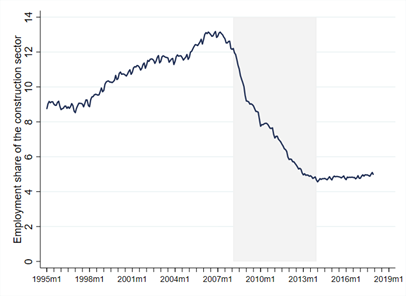How does a sudden and significant structural shift impact workers’ employment opportunities?
Several studies consistently show that job losses negatively affect workers’ long-term income. These consequences have been documented in various contexts, such as mass layoffs (Jacobson et al. 1993; Farber 2017; Gulyas et al. 2019) and economic downturns (Yagan 2019; Mian and Sufi 2014). Displaced workers’ income losses during a mass layoff can last 15 to 20 years. Despite substantial research documenting the persistent effects, little is still known about the fundamental reasons behind the large consequences and how workers respond to mitigate the effects. It remains puzzling that the impact of job loss events persists, despite the ability of workers’ geographical and sectoral reallocation to attenuate the impact.
What can workers do to mitigate the impact of job loss?
According to Topel (1986), a way of minimizing the negative repercussions of demand shocks is migrating to regions less affected by such shocks. Workers hit by a negative shock depart the affected region as unemployment rises, which helps to attenuate the workers’ impact on their job prospects while contributing to the local labor market adjustment. This mechanism is also described by Blanchard et al. (1992); the authors argue that regional differences in exposure to adverse demand shocks cause workers to migrate, eventually equalizing employment and income disparities across areas. However, recent literature suggests a modest worker mobility response. These findings do not imply that geographical mobility is ineffective but that this adjustment takes longer than previously suggested. The main consequence of demand shocks is to reduce in-migration rates into affected regions (Dustmann et al. 2017) rather than incentivize a migration response of workers in more distressed areas.
Additional adjustment mechanisms should be further investigated. One example that has received significant interest is sectoral mobility. The notion is similar to that of geographical mobility. If some sectors are more affected by an economic shock than others, then people may search for a broader range of jobs as a response, hoping to find one that closely matches their abilities. Additional factors, such as the composition of jobs at the local level and the workers’ skills, may influence this adjustment, as it depends on workers’ flexibility to be employed. Although there is little evidence of sectoral mobility, we are still puzzled about why not all workers are willing to relocate.

Figure 1: Employment share of workers in the Spanish construction sector, 2004-2017
Note: The figure shows the proportion of workers in the construction sector from January 2004 to December 2017. The data restricts to monthly observations of workers aged 20-60 years old and employed during the referenced period. The shaded area comprises the years of the Great Recession in Spain, between 2008 and 2014.
In my ongoing research, I investigate the impact of the Spanish construction sector’s employment burst during the Great Recession on worker mobility. This period saw a significant decline in employment within the industry, plummeting from 13% of total employment to less than 6% between 2007 and 2012 (as illustrated in Figure 1). Notably, this decline’s magnitude varied considerably across Spanish provinces. For instance, in Valencia, the employment reduction amounted to 60% of the construction workers employed in 2007, whereas in Zaragoza, the decline was slightly lower, 47%. But then, the question is how such a massive employment decline impacts the earnings of construction workers. To shed light on it, I leverage variation in the employment contraction of the construction sector across Spanish provinces. I determine how changes in local labor demand impact the workers’ earnings and employment.
The results show that workers in more exposed provinces experience a stronger decline in their cumulative income. This effect is mainly explained by workers having a harder time finding another job, i.e., longer unemployment/non-employment spells. These effects attenuate over time, such that in 2015 workers were equally likely to be employed irrespective of their province of residence before the Great Recession. Therefore, the pressing question is how workers within the construction sector adjust to cope with the shock.
Labor market adjustment to economic shocks
My research findings shed light on the primary response of workers to the employment decline in the Spanish construction sector, highlighting sectoral reallocation as a prominent response. Interestingly, my analysis reveals that the severity of job loss in a province’s construction sector does not appear to influence the likelihood of individuals relocating to another province. However, residing in a heavily impacted region significantly increases the probability of workers transitioning to a different sector. Notably, this effect becomes more pronounced over time, indicating a growing trend of workers seeking alternative employment opportunities outside the construction sector in strongly affected areas.
The next question is why some workers change sectors while others do not. I delve into the influence of skill mismatch on the sectoral reallocation response of construction workers to understand this further. As noted by by Schubert et al. (2019) and Yi et al. (2016), it is crucial to consider the local-level sectoral and occupational composition of jobs. These studies underscore the importance of such factors in shaping workers’ earnings and mitigating the consequences of job loss. By examining the interplay between sectoral reallocation and skill mismatch, I aim to gain insights into the underlying reasons behind workers’ decisions to either change sectors or remain in the construction sector.
I use a similar method to capture industry similarities as Caldwell and Danieli (2018). They developed an index that quantifies the value of workers’ outside options in Germany by comparing workforce composition across industries. In my study, I develop a reallocation index replicating the most likely shifts by integrating sector-specific appropriateness criteria.
This complete methodology gives a detailed picture of how industry dynamics and individual worker characteristics influenced job reallocation trends during the Great Recession. The findings indicate that mismatch is a significant component in understanding the diverse reaction of workers to such a substantial negative shock. Those with traits better matched to the composition of career alternatives in their province cope better with the loss of job opportunities caused by the construction sector’s downturn.
Let me provide a simple example interpreting the previous result. Consider two provinces where a similar group of workers lost their job: Province A and Province B. In Province A, a higher proportion of job opportunities closely match a worker’s skill set compared to the job opportunities in Province B. The distinction between the two provinces underscores the significance of incentives. Workers in Province A are incentivized to seek reemployment quickly, as there is a higher likelihood of finding a job that aligns with their existing skills. On the other hand, workers in Province B are faced with a different set of incentives. They may invest additional time and effort in acquiring new skills or undergo retraining to enhance their employability in sectors where job opportunities are more readily available.
Through this examination, it becomes evident that aligning workers’ skills with the available job opportunities plays a pivotal role in determining the impact of job loss. Recognizing this, policymakers have a crucial role in mitigating the negative consequences of job losses. As a concluding remark, it is essential to consider potential policy interventions that can assist workers in navigating these disparities effectively. One viable approach is to provide incentives, such as support for skill development or retraining programs. By offering opportunities for acquiring new skills or updating existing ones, policymakers can empower workers to adapt to changing labor market conditions and enhance their employability. These initiatives can foster resilience and facilitate smoother transitions for workers in the face of economic disruptions.
Further Reading:
Redondo, Henry. (2023). From bricklayers to waiters: Reallocation in a deep recession. Working Paper.
About the authors:
Henry Redondo is a Ph.D. candidate at Universidad Carlos III de Madrid. He is a labor economist with research interests in the causes of labor market inequality.
https://henryredondo.github.io/index/
References:
Blanchard, O. J., Katz, L. F., Hall, R. E., and Eichengreen, B. (1992). Regional evolutions.
Brookings Papers on Economic Activity, 1992(1):1–75.
Caldwell, S. and Danieli, O. (2018). Outside options in the labor market. Unpublished
manuscript.
Dustmann, C., Schönberg, U., and Stuhler, J. (2017). Labor supply shocks, native
wages, and the adjustment of local employment. The Quarterly Journal of Economics,
132(1):435–483.
Farber, H. S. (2017). Employment, hours, and earnings consequences of job loss: Us
evidence from the displaced workers survey. Journal of Labor Economics, 35(S1):S235–
S272.
Gulyas, A., Pytka, K., et al. (2019). Understanding the sources of earnings losses after
job displacement: A machine-learning approach. Technical report, University of Bonn
and University of Mannheim, Germany.
Jacobson, L. S., LaLonde, R. J., and Sullivan, D. G. (1993). Earnings losses of displaced
workers. The American economic review, pages 685–709.
Mian, A. and Sufi, A. (2014). What explains the 2007–2009 drop in employment? Econometrica,
82(6):2197–2223.
Schubert, G., Stansbury, A., and Taska, B. (2020). Employer concentration and outside
options.
Topel, R. H. (1986). Local labor markets. Journal of Political economy, 94(3, Part
2):S111–S143.
Yagan, D. (2019). Employment hysteresis from the great recession. Journal of Political
Economy, 127(5):2505–2558.
Yi, M., Müller, S., and Stegmaier, J. (2016). Industry mix, local labor markets, and the
incidence of trade shocks. Suitland, MD: US Census Bureau, mimeo-2017.



